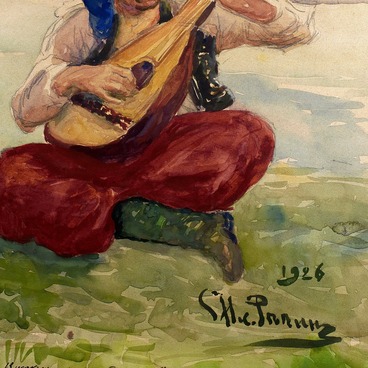The displayed antique bookcase is decorated with wood carvings. It consists of two sections. The upper section is removable, with two-leaved glazed doors and three shelves. The lower section has one shelf. Between the upper and lower parts of the bookcase are two sliding drawers.
In this bookcase, next to his desk, Sergeyev-Tsensky kept books by Russian classics, memoirs and critical literature about the classics: Alexander Pushkin, Mikhail Lermontov, Nikolai Gogol, and Ivan Turgenev. Their works influenced the writer’s style.
In the late 1920s and early 1930s, Sergeyev-Tsensky wrote a number of biographical works about the classics: “Pushkin’s Bride”, “Pushkin’s Marriage”, “Gogol Going into the Night” (about Gogol’s last days), the trilogy “Michel Lermontov” (“The Two Poets”, “The Poet and The Poetess”, and “The Poet and the Commoners”).
The bookcase contains editions in French, German, and English, including “Memoirs of the Duke de Saint-Simon” and “History of the Republic” by George Washington. There are also collected works by Russian and foreign writers: Maxim Gorky, Mikhail Sholokhov, Leo Tolstoy, Mikhail Prishvin, Ilya Goncharov, Dmitry Mamin-Sibiryak, Anton Chekhov, Guy de Maupassant, Émile Zola, George Byron, Heinrich Heine, Honoré de Balzac, and William Shakespeare.
Even a quick look at all the bookcases in the study and the library gives an idea of what the writer was interested in: art, history, philosophy, medicine, military science, agronomy, and local history. There are books on metallurgy, mining, and coke chemistry, that were given to the writer by the scientist and specialist in chemistry and coal coking Leonid Sapozhnikov. Sergeyev-Tsensky relied on these books when writing the novel “Seek, Always Seek!”. The choice of literature was largely determined by Sergeyev-Tsensky’s ideas for his works.
There are many books and magazines that Sergeyev-Tsensky left notes in, and they are of particular interest. The underlined words, the use of the abbreviation NB (from Latin “Nota bene” meaning “pay attention”), and the notes in the margins provide an insight into the writer’s thoughts during reading and his attitude toward the text and show how thoughtful and meticulous he was when working with a book.


